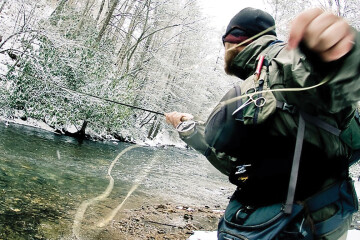Stalking Trophies

In the trout world there are very few greater feelings than head hunting and landing a trophy brown trout on a dry fly. Rivers such as the Henrys Fork, the Missouri River below Craig, and the various spring creeks that flow around the West provide the quintessential environment for this method of fishing. For the anglers willing to take a step back, observe their surroundings, and ignore the frequent rises of smaller fish, they will be rewarded with trophy trout right here in Bozeman. The Gallatin, Madison, and Yellowstone all provide ample opportunities to stick big browns on dry flies.
Swamp Donkeys, Toads, Walter Bronsons, and Slabrador Retrievers are all names indicative of the elusive brown trout. Big brown trout are cunning, crafty, wily, scheming, devious, deceitful fish. They are the apex predator in any Montana river system. They tend to stick to the shadows, waiting to ambush smaller fish and bugs that may swim or float by. They rarely show themselves and rarely make mistakes. They go wherever they want, whenever they want. Targeting these fish is difficult, and is best done under specific conditions. Big brown trout feed in low light. Early mornings, late evenings, and the nastiest surly, rainy days usually get these fish on the feed. Every once in a while, when the stars align, the jaws of large trout gently sipping bugs can be spotted in the smallest nooks and crannies of a river.
The key to stalking large trout on dry flies is observation. Waiting, watching, and analyzing a river before making a cast can often reveal subtleties that go unnoticed by the hordes of migratory anglers that frequent Montana every summer. Fishing for big browns is a hunt. And much like hunting, scouting is critical to success. The first step in fishing for big browns is finding an area where big browns live. It’s a slow game, once a big fish is located and conditions are right, do not rush your shot. Take your time and make the first cast count. As with any trophy worth hunting, you rarely get two shots. Watching the fish before casting can reveal its feeding rhythm. For example, often times a fish will be eating every third bug, or even feeding every 25 seconds. Take 5 minutes and figure out what rhythm the fish is in. Synchronize your cast with the rhythm of the fish. Get close enough to make a cast with confidence, have exactly the right amount of line for the cast, and make sure your fly is dressed to float and in good condition. Be ready, if the fish is feeding well, he is going to eat.
If conditions are right but fish are not feeding, move on and find a new area to explore. Spot and stalk is an effective method for locating big fish. If the bugs are there and the light is low, the fish will be there, you just have to find them. If it’s pitch dark, hearing can help locate a feeding fish. Stand in some slower water and listen to the river. Don’t fish while you move, watch the water and listen. Bigger fish feeding can be difficult to spot and nearly impossible if you’re trying to focus on fishing at the same time. Walk, watch, and be patient. Eventually, the faint chomp of a fish’s mouth closing can be heard.
On a recent trip to a river around Bozeman, I watched as my car windshield got peppered by the surplus of caddis and sedges that surrounded the bushes near the banks and bounced gently off the edges of the river. As I drove over a small tributary stream, I noticed the peppering stopped and all of a sudden I was surrounded by a swarm of small mayflies dancing up and down in the sky. As I rigged my rod, I couldn’t help but notice a small pod of risers splashing around after the elusive caddis skating around near the bank. I picked off a few of the small rainbows as I waited for the cover of darkness to draw the browns out of their lairs. As the sun set behind the mountains, the evening stayed warm and the wind died down. Immediately I looked to the sky. About 100 feet up, there was the unmistakable rise and fall of thousands of tiny spinners. I went straight to my car and grabbed my box of spinners. I rushed back to the river and began watching. I kept an eye on the water and noticed the spent spinners starting to fall. In about ten minutes the bugs grew in numbers on the water from a bug every 20 feet to a bug every 6 inches in the current lanes. I watched as small fish gorged themselves on the helpless lifeless bugs. I slowly walked, covering two miles of river while scoping out the likely big brown holding water. Finally, I heard the faint snap of a large trout’s mouth closing on a bug. I stopped and scanned the river and eventually noticed the kyped up snout of a large brown sipping bugs and barely causing a surface disturbance in a small micro seam a few feet off the bank. I watched the fish, and estimated his timing to be a feed about every 45 seconds. I snuck up and laid the small spinner pattern in his lane and his big nose came up and inhaled the small bug. After a few minutes, the brown trout lay in the net. I removed the fly and watched the fish slink back into the shadows to rise another day. Two miles, one cast, and one fish made for a great evening. There is no greater feeling than putting in the time and effort in pursuit of trophy trout and having it pay off!
Jake “Wally” Walbridge is an employee at Bozeman’s oldest fly shop, Montana Troutfitters.
